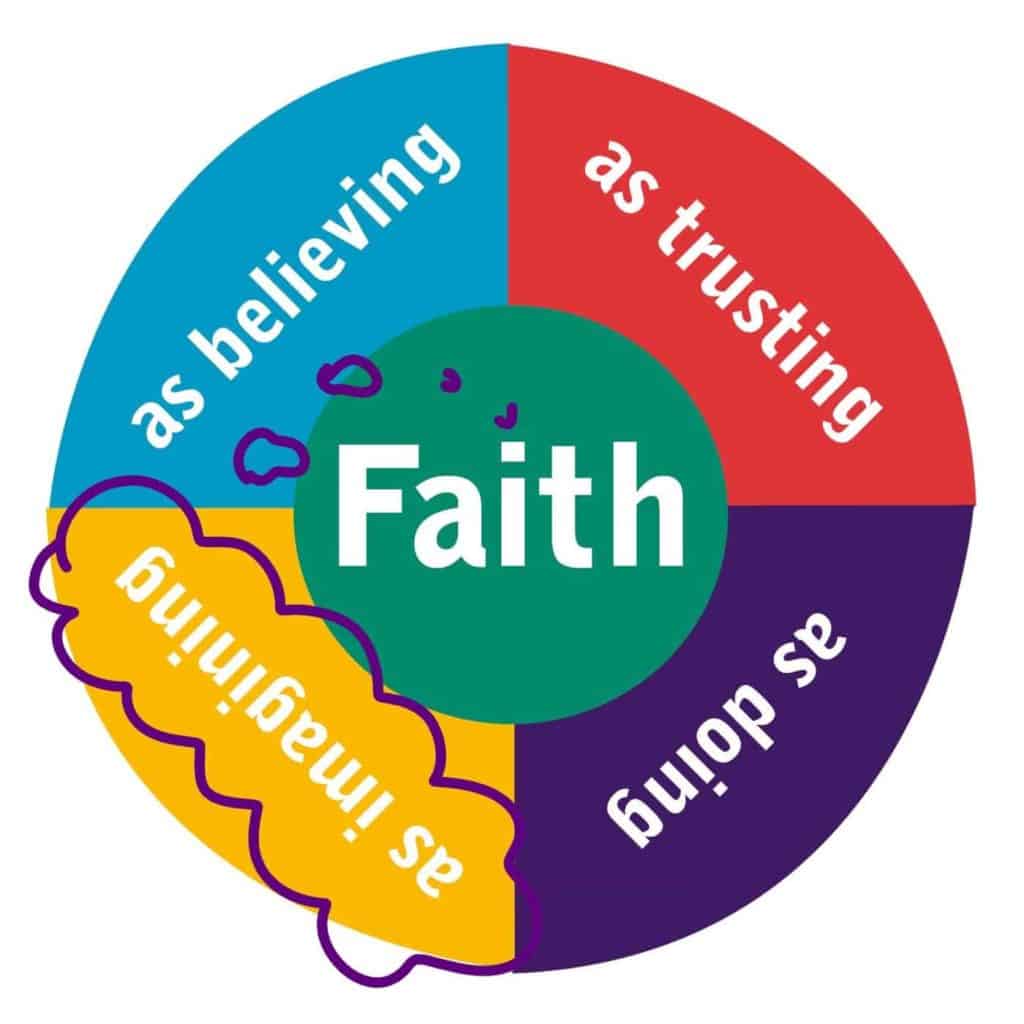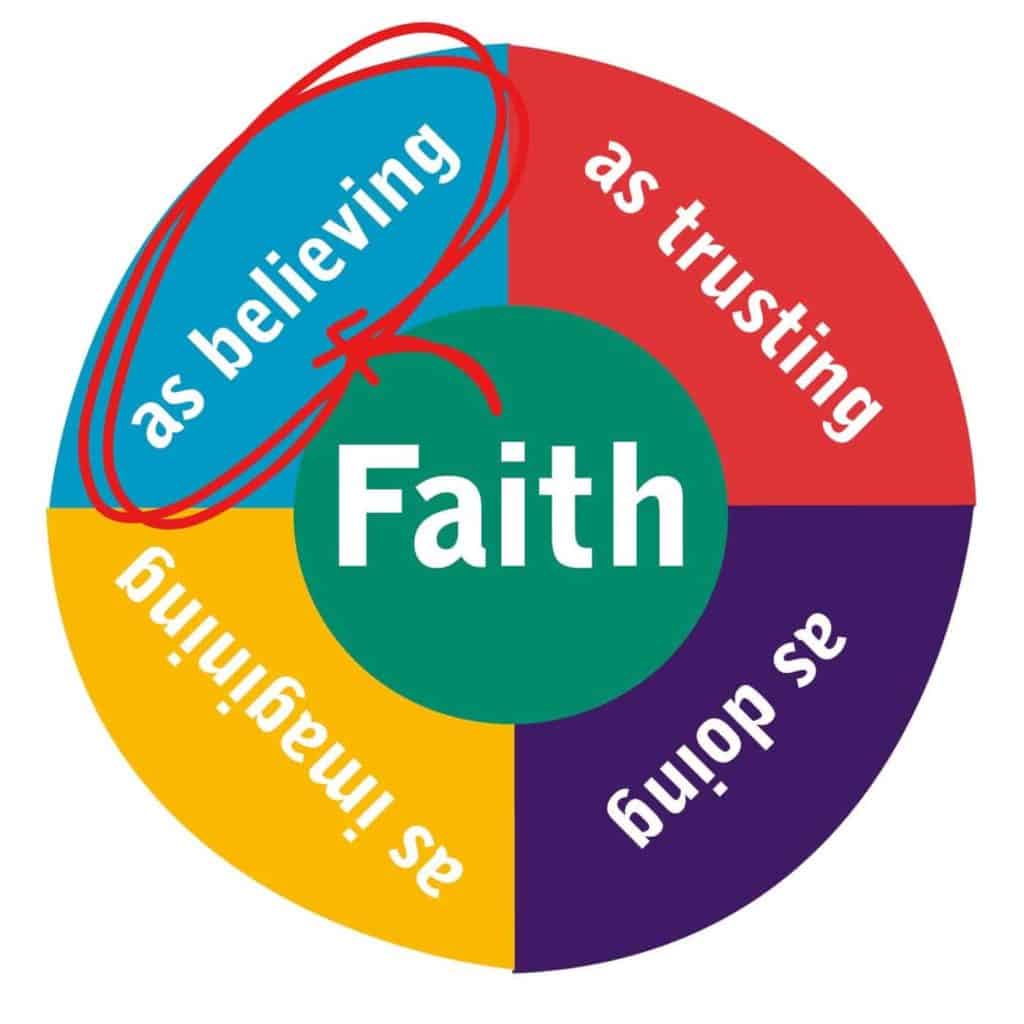
What is faith? When asked this, I usually get a variety of answers, including belief, trust and action. I recently asked this on Facebook Live, and the answers included hope, trust, or belief in someone or something we can’t see or feel. These answers are a lot like Hebrews 11:1:
“Faith is confidence in what we hope for and assurance about what we do not see.”
And although none of the people mentioned imagination, the fact that they defined faith, by the way, we can’t see or feel God means that by default faith needs to involve our imagination.
In the book Children Finding Faith, Francis Bridger describes faith as believing, trusting, doing and imagining. But why is imagination an important part of faith?
Why is imagination an important part of faith?
Maybe we don’t consider imagination as important as our style of spirituality has often been word-based, focusing most on believing, understanding and knowing. Imagination is personal and subjective. It has connotations of heresy.
However, Bridger suggests that we need to use our imagination if our faith is to be balanced. The book talks about imagination as the creation of images – some of which are of places we have created (e.g. imaginary worlds) – and some of which are places where we have been but are not presently in (e.g. a sunny beach) or places we have never been, such as places in the Bible. Bridger describes how imagination is a way of seeing life, how it transforms life, and how it opens windows onto another reality. If we cannot imagine anything past what we can see, feel and hear, how can we engage in a relationship with an invisible God? How can we pray for things which currently do not exist? How can we be part of building the often invisible kingdom of God?
Does the Bible encourage us to use our imagination?
A quick look reveals Jesus teaching people in an imagination style for example, the kingdom of God is like… a field … a man who scatters seed … a mustard seed. The Psalms and prophetic books use loads of visual imagery to communicate complex concepts and emotions, which we need to use our imagination to connect with their message.
Ephesians 3:20 says God is able to “do immeasurably more than all we ask or imagine”. This doesn’t seem as if God is limited by what we know and understand, but that His power works far beyond that, and so if we are to relate to Him, we need to be open to more than we can know, into the realm of what we can imagine, and even more!
What role does imagination play in our faith?
Rebecca Nye, in her thought-provoking book, Children’s Spirituality, says that helping children use their imagination to develop skills they need to “sift through layers of meaning and make new discoveries”.
Bridges talk about how the word imagination is about images that we create, images of places we create (e.g. imaginary places) and place which exists but where we have never been (eg. Places and times in the Bible).
The Bible is full of stories about God’s interactions with people which can explore imaginatively, for example, by imagining it was like to actually be there. As we do this, we discover their encounters with God and thus our own in a fresh and intimate way.
How could we develop the use of imagination in faith?
Rebecca Nye suggests three ideas to help develop imagination:
1 Using imaginative ‘warm up’ exercises.
She suggests asking people to guess what a story prop might be or might be used for. It’s important there’s actually space to imagine and guess, rather than the answer being obvious!
2 Embracing silly things children say and do
Ask them for more info and go down their ‘rabbit hole’. Often the most seemingly disconnected thoughts actually yield interesting connections and meaning.
3 Giving children free choice of what they create in response to the Bible story.
I love doing this as it means I can share a story and then give children choice as to what to do in response to it. No craft prep, just open-ended materials set out in an inviting way. In a home setting, this can be as simple as using the art materials and construction toys we already have. My children will sometimes create things straight after hearing a Bible story or later at their leisure.
Some of the other things we’ve found help us develop imagination in our faith at home are:
4 Reading Christian fiction.
We’ve recently read The Scarlet Cord, a fictional re-telling of the story of Jericho told from the perspective of four children, 2 Israelites and 2 Canaanites from Jericho. Through their eyes, we get to imagine what it would have been like to be there. I really enjoyed reading the chapter just before they crossed the Joran when they don’t yet know God’s plan to get them across, and reflecting on the different responses of the characters to this uncertainty. Sometimes when a story is familiar to us, we forget that these are real people experiencing relationships with the same God as me.
5 Using toys to play Bible stories.
We use Play Mobil to act out stories. Sometimes we photograph them and sometimes even use the photos in our photobook versions of the stories. We’ve created books for stories which are hard to find in children’s Bible story books such as Esther and Josiah.
I find it interesting that using toys like this allows children (and adults!) to place themselves in the story. Once we were playing the feeding of the 5000 with Play Mobil and my girls found two long-haired female figurines to be them, and placed them in a circle with all the other children … and Robin Hood and Maid Marion! I’m not sure to this day why the children were in a separate circle – perhaps this reflected church where the children are often segregated – or why Robin Hood was there. However, the purpose of this imaginative play, like any other play, is not for me to understand their thinking, but to give creative expression to concepts they are exploring. If I get a glimpse into their world, that is just a bonus.
6 Employing ‘wondering questions’ when reading the Bible.
These are open-ended questions which give everyone a chance to ponder and reflect on their own encounter with the text. We use questions from Godly Play such as:
I wonder which part of this story you like best / is the most important part. I wonder where you might be in this story.
And other questions like:
I wonder how they would have felt at this point. I wonder what they considered doing /saying.
I wonder who else might have been there.
I wonder how this could have ended differently.
These questions really level the playing field when exploring the Bible as a family, as being the answers are personal and subjective, rather than right or wrong, everyone can answer (or not!) as they choose.
Which of these might you try?
Feel free to get in touch and ask questions or let me know how you get on. You can find me on Instagram or my Facebook page: GodVenture

Next in the series: Faith as believing
